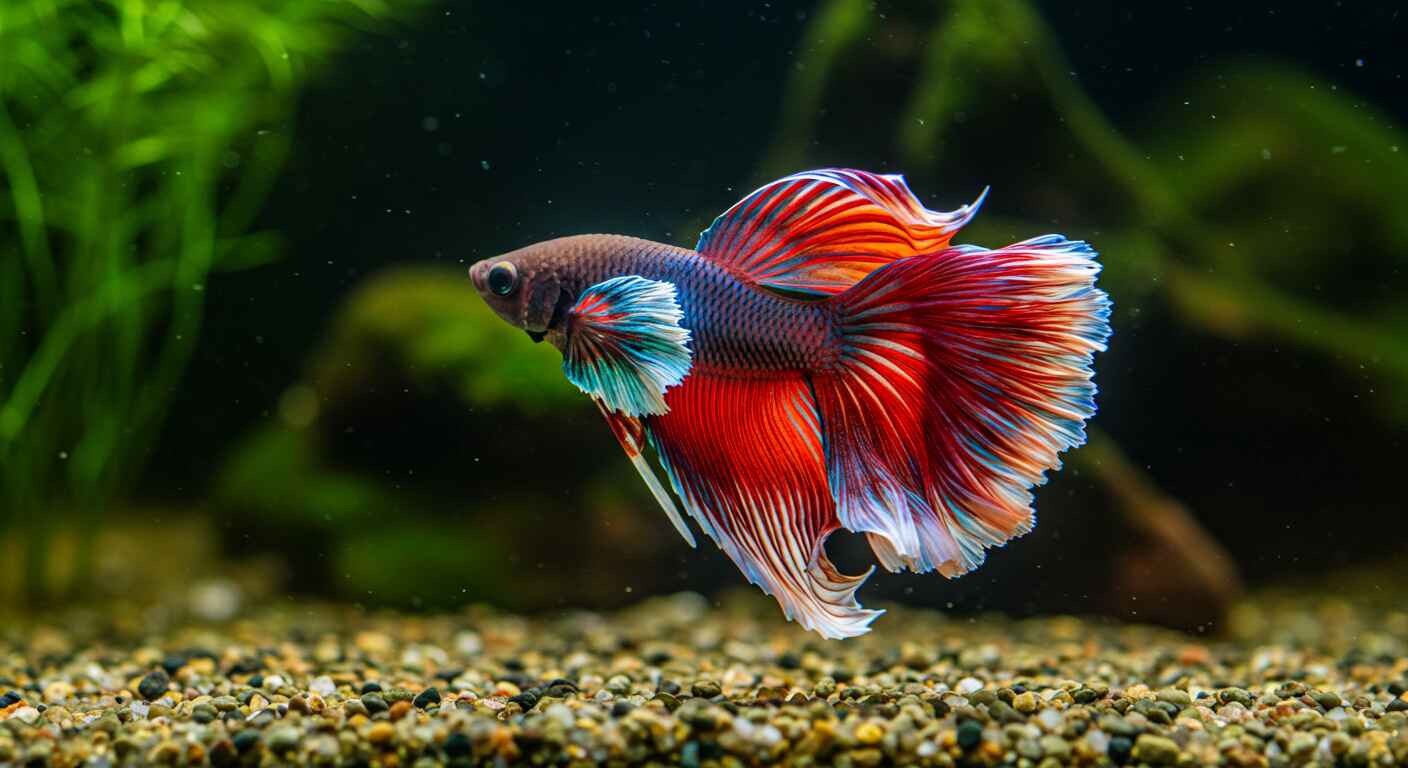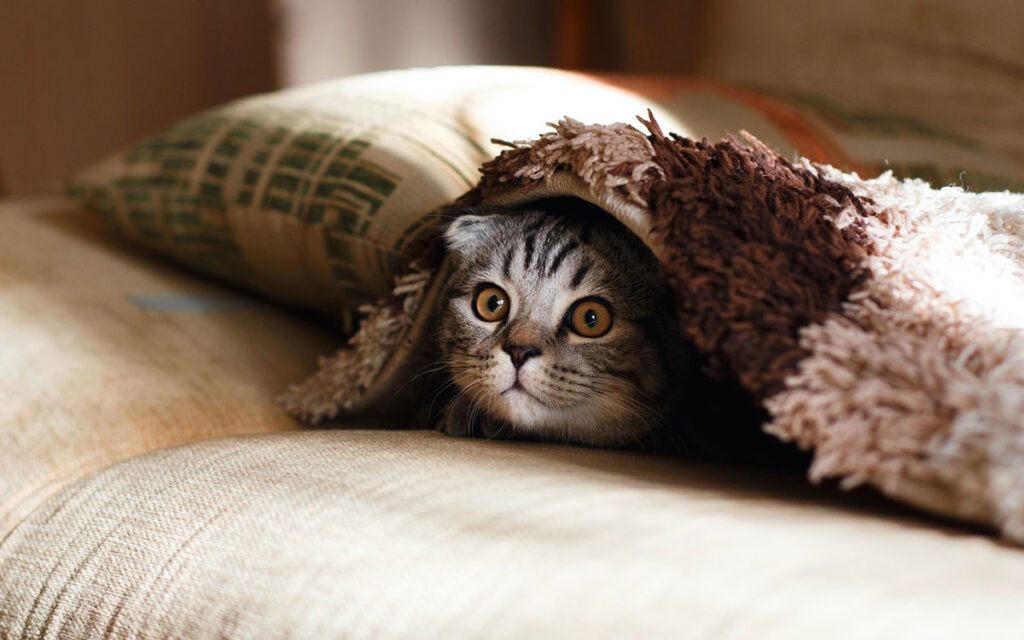Low-maintenance fish for small tanks, that is the kind of list I wish I had when my younger cousin set up her first aquarium. She walked out of the pet store clutching a 5-gallon tank and absolutely no idea what fish to choose. It brought me back to my own childhood, where Sundays meant dogs on laps, cats on windowsills, and Charlie the parrot shrieking across the room.
That love of pets is what built this blog. Whether you are new to fish keeping or just want to add some calm to your space, this guide to low-maintenance fish for small tanks will help you get it right from the start.
Table of Contents
Table of Contents
Why Choose Low-Maintenance Fish for Small Tanks?
What Makes a Fish “Low-Maintenance”?
Not all fish need complex filtration, delicate water parameters, or daily attention. Low-maintenance fish for small tanksare hardy species that adapt well to beginner-friendly setups. They tolerate slight changes in water conditions, eat a standard diet of flakes or pellets, and don’t require constant monitoring.
These fish:
- Thrive in tanks under 20 gallons
- Eat easily available, affordable food
- Have a peaceful temperament, reducing aggression issues
- Can live alone or with compatible mates
- Don’t need high-tech equipment or heating (in some cases)
That means fewer stress headaches for you, and a much better chance of long-term success.
Don’t miss our guide to fish that fit perfectly in small homes
Benefits of Small Aquariums for New Pet Owners
If you’re new to the aquarium world, a small tank stocked with easy-care fish is the best place to start. Here’s why:
- Less space required – Fits on a desk or small shelf
- Lower startup costs – Budget-friendly equipment and fish
- Faster setup time – No plumbing or massive filters needed
- Easier maintenance – Fewer gallons to clean or cycle
- Great learning tool – Teaches core aquarium skills
But it’s important to choose your fish wisely. Many beginners are tempted by pretty fish that require precise care, like goldfish or angelfish, which aren’t ideal for smaller tanks. That’s why choosing from our list of low-maintenance fish for small tanks sets you up for success without the stress.
Next up, we’ll make sure your tank setup is done right before any fish are introduced.
Essential Setup Tips Before Adding Fish
Tank Size, Water Quality & Equipment Essentials
Before you choose your favorite low-maintenance fish for small tanks, it’s critical to get your aquarium setup right. Even the hardiest species need a stable environment to thrive. A common myth is that small tanks are easier, but in truth, they require more precise attention to water quality.
Here’s what every beginner tank should have:
| Equipment | Why It Matters |
|---|---|
| Filter | Keeps water clean, removes toxins, provides oxygen |
| Heater (if needed) | Stabilizes temperature (especially for tropical fish) |
| Thermometer | Monitors heat fluctuations accurately |
| Water Conditioner | Neutralizes harmful chlorine from tap water |
| Gravel/Substrate | Supports plant roots and hosts beneficial bacteria |
| LED Lighting | Enhances fish color and supports live plants |
Even for low-maintenance fish, a 5-gallon tank is the minimum recommended size for most species. It is small, but not too small to cause water fluctuations or stress.
Always cycle your tank for 2-4 weeks before adding fish. This builds up healthy bacteria that break down fish waste, helping to prevent ammonia spikes (a silent killer for new tanks).
Discover great ideas like how to safely cycle your new tank
Common Mistakes Beginners Make in Small Tank Setups
Small tanks are charming, but they’re also less forgiving. Here’s where many first-time fish keepers go wrong:
- Overstocking: Too many fish in too little water leads to aggression, waste buildup, and stress. Stick to the recommended fish count per gallon.
- Skipping the cycling phase: Adding fish to an uncycled tank is the fastest way to see them struggle, or worse.
- Using untreated tap water: Chlorine and chloramine in untreated tap water can be fatal to fish.
- Inconsistent water changes: Even hardy fish need clean water. Do 25-30% partial water changes weekly.
- Ignoring pH or temperature changes: Drastic shifts can stress even low-maintenance species.
If you’re serious about finding the best low-maintenance fish for small tanks, giving them a stable home first is the most important step.
Betta Fish: The Vibrant Solo Swimmer
Why Bettas Are Perfect for Small Spaces
When it comes to low-maintenance fish for small tanks, betta fish are one of the most popular, and for good reason. With their flowing fins, bold colors, and peaceful routines, bettas make stunning solo tank companions.
What makes them ideal for beginners?
- They thrive alone, so no worries about compatibility issues.
- They tolerate low oxygen levels thanks to their labyrinth organ, which allows them to breathe air.
- They do well in tanks as small as 5 gallons, though more space is always better.
- They’re interactive and often recognize their caretakers.
Unlike many tropical fish, bettas don’t require constant aeration or complex filtration systems, though a gentle sponge filter and heater are still recommended.
Check out our detailed guide to caring for bettas in smaller tanks
Feeding, Water Conditions & Compatibility
Feeding your betta is simple, another reason they’re among the best low-maintenance fish for small tanks. Offer high-quality betta pellets once or twice daily, and supplement with:
- Freeze-dried bloodworms
- Brine shrimp
- Occasional mosquito larvae (live or frozen)
Avoid overfeeding; their stomach is only about the size of their eye. Uneaten food can quickly pollute a small tank.
For water conditions, aim for:
- Temperature: 76-82°F (they’re tropical fish)
- pH: 6.5-7.5
- Gentle water flow to prevent fin damage
Important Note: Male bettas should be kept alone. Females can sometimes live in sororities, but this requires more space, hiding spots, and careful monitoring. For simplicity, stick to a solo betta in a small, filtered, heated tank.
Bettas are low-effort yet striking, a perfect match for those wanting beauty without the fuss.
Zebra Danios: Fast, Hardy, and Fun
Care Requirements and Ideal Tank Conditions
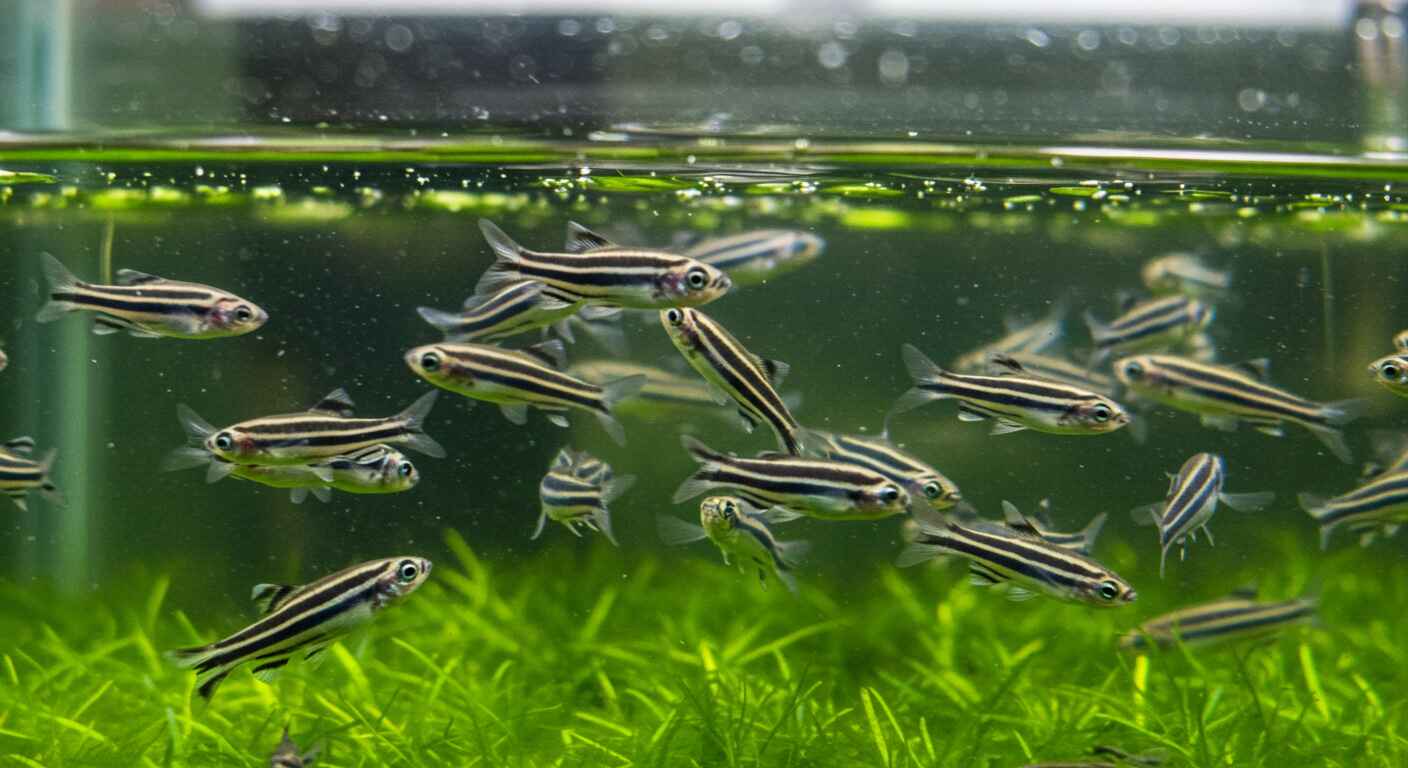
Zebra Danios are tiny torpedoes, full of energy and personality. They’re one of the best low-maintenance fish for small tanks because they’re incredibly hardy, even for complete beginners.
Why they shine in smaller setups:
- Tolerate a wide range of water conditions
- Rarely fall sick when kept in clean, cycled tanks
- Easily available and budget-friendly
- Active schooling behavior, which adds life to the aquarium
Zebra Danios thrive in tanks as small as 10 gallons, especially when kept in groups of 5 or more. Though active, they’re peaceful and get along with many tankmates like cory catfish and guppies.
Ideal water conditions:
- Temperature: 64-75°F (no heater needed in room temp homes)
- pH: 6.5-7.2
- Tank Decor: Open swimming space with some plants or hiding spots
If you’re looking for low-maintenance fish for small tanks that are fun to watch and easy to care for, Zebra Danios are hard to beat.
Discover great tips on beginner fish care and small tank setups
Why Zebra Danios Are Great for Community Tanks
Zebra Danios are social, they thrive in schools and do best when surrounded by their own kind. Keeping them in a group not only reduces stress but also brings out their bold, striped coloration.
They don’t nip fins, bully smaller tankmates, or require constant temperature regulation, making them one of the most compatible fish for nano community tanks.
Feed them:
- Flake food (daily)
- Micro pellets
- Occasional live or frozen food like daphnia or brine shrimp
They’re low-drama, high-energy, and ultra-forgiving, ideal for hobbyists just starting out.
White Cloud Mountain Minnows: Chilly-Water Champs
Temperament, Tank Mates & Care Tips
White Cloud Mountain Minnows are underrated gems, peaceful, playful, and perfect for cooler climates. If you’re looking for low-maintenance fish for small tanks that don’t need heaters, these little guys are ideal.
Their gentle nature makes them excellent for community aquariums, and their shimmering bodies add visual appeal without high care demands. Best of all, they don’t require tropical temperatures, making them ideal for room-temperature homes.
Here’s what they need to thrive:
- Tank size: 10 gallons or more
- Temperature: 60-72°F
- pH: 6.0-8.0
- Group size: At least 5 to reduce stress
- Behavior: Peaceful and schooling
They get along with danios, corydoras, and shrimp, but avoid housing them with aggressive or fin-nipping fish. Their calm demeanor makes them a top pick for beginner aquarists who want an easy-care tank setup.
Looking for inspiration? Try our guide on peaceful community fish
Feeding Frequency and Water Preferences
Feeding White Clouds is a breeze, another reason they rank high among low-maintenance fish for small tanks. Offer them:
- High-quality micro flakes or pellets
- Live or frozen foods like bloodworms and brine shrimp
- Occasional veggie-based options (spirulina flakes)
Feed once or twice daily, and only what they can eat in 2 minutes to avoid water quality issues.
They’re also resilient to slight changes in water conditions, which is great for beginners still learning tank care routines. As long as the tank is clean and cycled, these fish are happy.
Whether you’re stocking your first tank or looking to expand a peaceful nano community, White Cloud Mountain Minnows are hardy, beautiful, and rewarding, exactly what you want in low-maintenance fish for small tanks.
Neon Tetras: Colorful and Peaceful
Schooling Behavior and Tank Needs
If you want a pop of color and gentle movement in your setup, neon tetras are a classic choice among low-maintenance fish for small tanks. With their glowing blue and red stripes, they create a striking visual, especially in groups.
Neon tetras are:
- Extremely peaceful
- Easy to feed
- Happy in well-maintained nano tanks
- Known for their schooling behavior, so keep them in groups of 6 or more
Tank needs include:
- Tank size: Minimum 10 gallons
- Temperature: 70-81°F
- pH: 6.0-7.0
- Lighting: Low to moderate (they prefer soft lighting)
- Tank mates: Ideal with other peaceful fish like guppies, snails, and shrimp
They do require stable water conditions, but once established, they’re easy to maintain, just another reason why they’re loved by beginner aquarists building tanks with low-maintenance fish for small tanks.
Feeding and Health Maintenance
Feeding neon tetras is quick and low-effort, fitting perfectly into any list of low-maintenance fish for small tanks. Give them:
- High-quality tropical flake food
- Micro pellets
- Occasional frozen or freeze-dried bloodworms or brine shrimp
Feed small portions once or twice daily and remove uneaten food quickly.
To keep them healthy, perform weekly water changes and avoid fluctuating temperatures. Use a sponge filter or low-flow option to mimic their natural, calm water environment.
Signs of good health include:
- Bright, vibrant color
- Tight schooling
- Active swimming throughout the day
Neon tetras are peaceful, pretty, and perfect for compact aquariums, making them a timeless favorite among those seeking low-maintenance fish for small tanks with big personality.
Cory Catfish: The Friendly Bottom-Dweller
Cleaning Habits & Tank Benefits
Cory catfish are like the cheerful janitors of your aquarium. Always scooting along the bottom, these little helpers are fantastic for small tanks, and they’re one of the most loved low-maintenance fish for small tanks thanks to their peaceful nature and helpful habits.
Why they’re ideal:
- Constantly clean up leftover food and waste
- Very social and peaceful (great in groups of 3 or more)
- Don’t bother other tankmates
- Thrive in well-oxygenated tanks with smooth substrate
Corys are especially useful for nano tanks that tend to accumulate uneaten food quickly. Just remember, they’re not “tank cleaners” in the sense that they replace maintenance. But they do reduce buildup, helping you keep your tank tidy between water changes.
What They Eat and Ideal Companions
Feeding cory catfish is simple. Although they’ll scavenge bits that fall to the bottom, you should still provide them with:
- Sinking pellets
- Algae wafers
- Blanched vegetables (like zucchini)
- Frozen bloodworms or daphnia
Their diet is low-maintenance, just like their care. That’s why they’re one of the best choices for anyone building a tank around low-maintenance fish for small tanks.
Tank companions should include peaceful mid-to-top dwellers like:
- Neon tetras
- Guppies
- Endlers
- White cloud minnows
Avoid housing them with aggressive or fin-nipping species.
Corys are fun to watch, easy to feed, and a joy to care for. For new aquarists, they strike the perfect balance between activity and simplicity.
Endler’s Livebearers: Hardy, Tiny, and Active
Breeding Habits and Maintenance Level
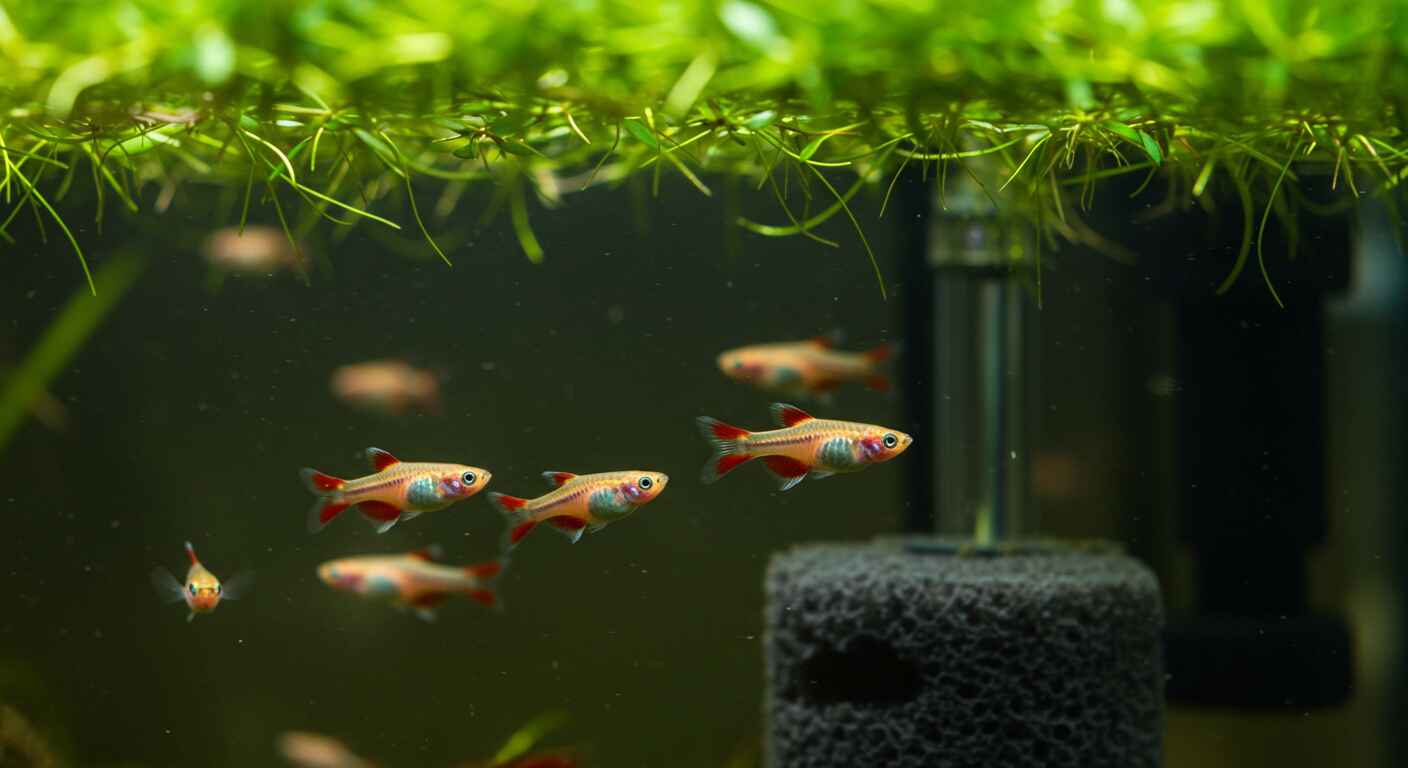
If you’re on the hunt for colorful, active companions, Endler’s Livebearers are a fantastic choice. These tiny swimmers are hardy, adaptable, and ideal for anyone putting together a tank filled with low-maintenance fish for small tanks.
A close cousin to guppies, Endlers:
- Thrive in 5-10 gallon tanks
- Reproduce easily and often
- Are super active and full of personality
- Do well in basic water conditions with minimal intervention
They’re one of the best fish for nano tanks, not just because they’re small, but because they don’t need complex filtration or strict temperature regulation. Their simple needs make them a standout in any list of low-maintenance fish for small tanks.
Check out our nano tank tips for small livebearer species
Ideal for Nano Tanks and Planted Setups
Endlers truly shine in planted aquariums, where their bright colors pop against greenery, and their offspring can hide among leaves and moss. You can safely pair them with:
- Cory catfish
- Shrimp
- Peaceful rasboras or tetras
Avoid aggressive fish or larger tankmates that may stress or outcompete them.
Feeding is equally low-effort:
- High-quality flakes or micro pellets
- Spirulina-based food or crushed veggie flakes
- Occasional live/frozen daphnia or brine shrimp
They eat fast, waste little, and tolerate minor water fluctuations, all reasons they belong on any list of low-maintenance fish for small tanks that are beginner-friendly and low-stress.
If you’re curating a peaceful, vibrant aquarium with minimal upkeep, Endler’s Livebearers bring life, color, and charm without the hassle.
Guppies: Beautiful and Beginner-Proof
Care Tips, Lifespan & Feeding
If you’re building your aquarium with low-maintenance fish for small tanks, guppies are a must-have. These colorful livebearers are adored by beginners for their hardiness, adaptability, and vibrant variety.
Why guppies are beginner-friendly:
- They thrive in small tanks (10 gallons and up)
- They tolerate a range of pH and temperatures
- Their diet is simple and affordable
- They’re social, peaceful, and endlessly entertaining
You can keep a trio of guppies, ideally two females per male, to minimize stress and overbreeding. Their peaceful nature also makes them great tankmates for shrimp, cory catfish, and tetras.
Tank Requirements:
- Temperature: 72-82°F
- pH: 6.8-7.8
- Lighting: Moderate
- Filtration: Gentle flow with weekly water changes
They’re one of the easiest species to care for in any setup designed around low-maintenance fish for small tanks.
Don’t miss our guide to feeding small tropical fish the easy way
Common Variations and Water Needs
Guppies come in a dazzling range of tail shapes and color combinations. Whether you prefer solid colors or multi-patterned fish, you’ll find a type that fits your style, and your tank.
Popular variations:
- Fancy guppies (fan tails, lyre tails)
- Endler hybrids (smaller, more active)
- Metallic and snakeskin color strains
Feeding is simple:
- Flake or pellet food
- Crushed spirulina or veggie-based flakes
- Occasional frozen or freeze-dried brine shrimp
Guppies adapt quickly to their surroundings and require minimal effort to keep healthy. That’s why they consistently top lists of low-maintenance fish for small tanks for new aquarists and busy owners alike.
If you want a mix of beauty, personality, and ease, guppies will exceed your expectations.
Cherry Shrimp & Snails: Low-Maintenance Clean-Up Crew
Why Shrimp and Snails Are Great Tankmates
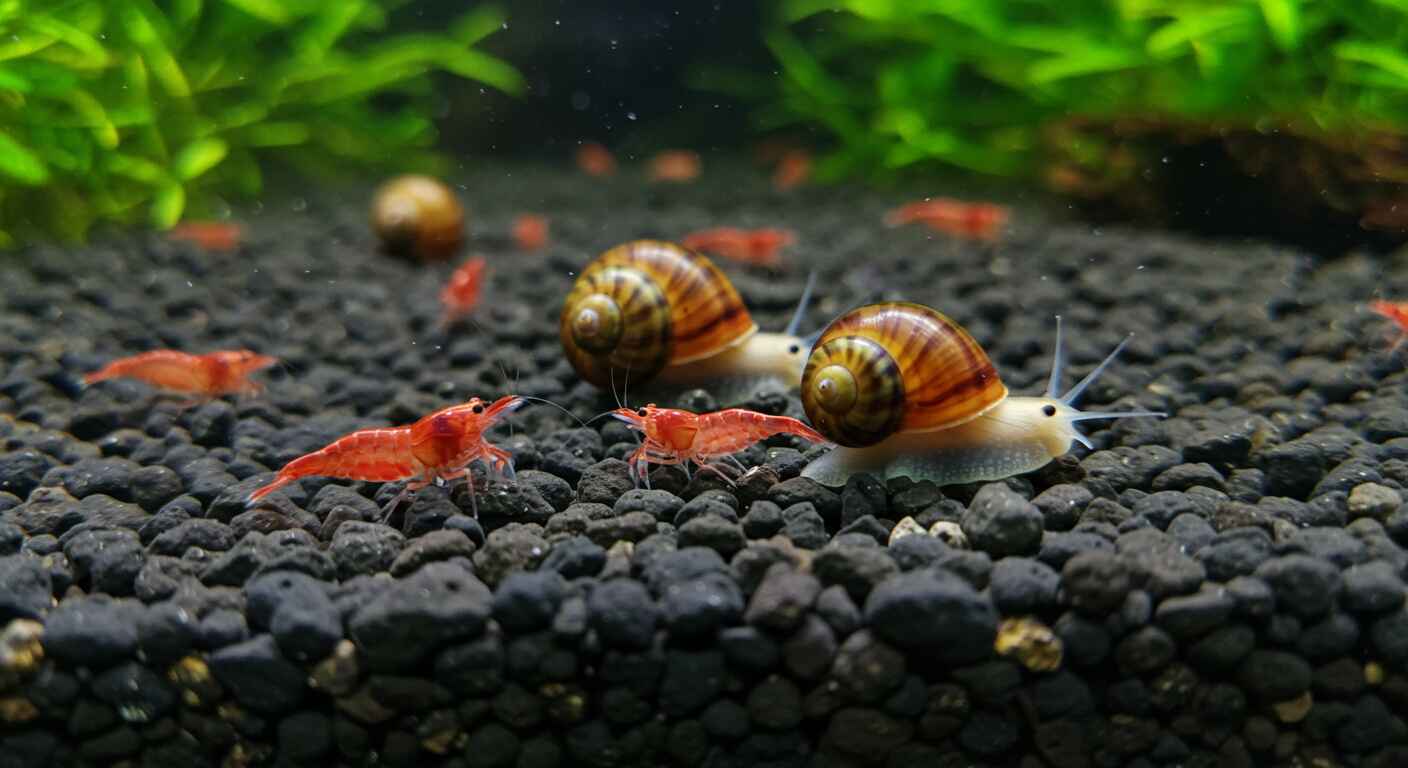
When most people think of low-maintenance fish for small tanks, they picture colorful swimmers, but don’t overlook the incredible value of shrimp and snails. These invertebrates not only add personality and variety but also play a vital role in keeping your tank clean.
Cherry shrimp and Nerite snails are top choices because:
- They consume leftover food, algae, and detritus
- Require minimal feeding
- Are peaceful and non-intrusive
- Add pops of color and charm to nano tanks
They’re ideal for beginners because they tolerate a wide range of parameters and don’t need much space or attention. Plus, they pair beautifully with fish like guppies, tetras, and Endlers in low-maintenance fish for small tanks setups.
Explore our guide on peaceful tankmates and algae-eating species
Minimal Care Requirements & Compatibility
Here’s what they need:
| Species | Tank Size | Temp Range | Notes |
|---|---|---|---|
| Cherry Shrimp | 5+ gallons | 65-80°F | Best in groups, love plants |
| Nerite Snails | 5+ gallons | 70-78°F | Don’t reproduce in freshwater, low mess |
Frequently Asked Questions About Low-Maintenance Fish for Small Tanks
What is the easiest fish to take care of in a small tank?
Betta fish are often considered the easiest fish to care for in small tanks. They can live comfortably in as little as 5 gallons, tolerate fluctuating conditions, and require minimal feeding. That makes them a top choice when selecting low-maintenance fish for small tanks.
How many low-maintenance fish can you keep in a 5-gallon tank?
It depends on the species. For a 5-gallon tank, a single betta, a small group of Endler’s livebearers, or a few shrimp and snails are best. Overstocking leads to poor water quality, so choose wisely from compatible low-maintenance fish for small tanks.
Can I mix different low-maintenance fish in a small tank?
Yes, but you must choose species that are peaceful and size-appropriate. A small tank can host guppies, shrimp, and a snail, for example. Mixing low-maintenance fish for small tanks works best when you match temperament, space needs, and feeding habits.
Do low-maintenance fish need heaters or filters?
Some do. Tropical fish like guppies and neon tetras need heaters, while cold-water species like white cloud minnows do not. All small tanks should have a filter, even for low-maintenance fish for small tanks, to maintain water clarity and reduce toxins.
What do low-maintenance fish eat?
Most eat standard flakes or pellets. Some may enjoy occasional frozen or live treats. Guppies, bettas, and tetras are all examples of low-maintenance fish for small tanks that thrive on basic, inexpensive food options.
How often do you clean a small tank with easy fish?
Ideally, clean your small tank once a week with a 25-30% water change. Even with low-maintenance fish for small tanks, regular cleaning helps prevent ammonia spikes and keeps your aquarium healthy and balanced.
Conclusion
Finding the right low-maintenance fish for small tanks is the first step toward building an aquarium that’s easy to manage and full of life. Whether you choose the bold personality of a betta, the vibrant movement of guppies, or the quiet help of cherry shrimp and snails, each species brings something special to your tank.
What matters most isn’t just the fish, it’s the balance you create. A clean tank, consistent feeding, and regular water changes go a long way in keeping even the most beginner-friendly fish thriving.
If you’ve made it this far, you’re already on your way to being a responsible fishkeeper. Ready to dive in? Your small tank is about to become your favorite spot in the house.
Check out more small tank tips and freshwater ideas to keep your aquarium healthy and fun

